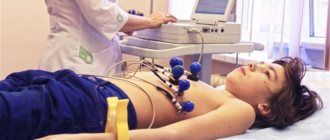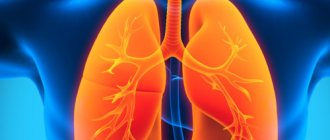Causes of newborn asphyxia
According to obstetric statistics, asphyxia is not so common; to one degree or another, it is diagnosed in only 4-6% of infants. Various factors that are directly related to the course of pregnancy, the general health of the mother, aspects of the intrauterine development of the unborn child and the process of labor itself can lead to the development of a child’s state of suffocation during and after childbirth. Based on the characteristic signs and time of development of oxygen starvation and suffocation, newborns are divided into two categories.
Primary (congenital) asphyxia is formed in the fetus due to hypoxia, secondary (postnatal) - in the newborn during the first 24 hours from the moment of birth.
What to do after discharge from the maternity hospital?
A child who has suffered oxygen deficiency during birth requires subsequent outpatient observation by a pediatrician, as well as consultations with a neurologist. It is important to promptly identify and prevent disorders in the central nervous system, as well as directly in the brain.
What affects doctors’ prognosis:
A secondary assessment of the baby’s condition is carried out after 5 minutes from the start of therapy. And it is important that the re-assessment be higher than the original one . This significantly affects the subsequent prognosis.
What complications are possible later:
Primary asphyxia
The primary cause of asphyxia is abnormal processes and pathological conditions in which the unborn child’s breathing process is disrupted and he experiences a gradual and prolonged or acute lack of oxygen (chronic or acute form of suffocation). Such conditions can be caused by chronic diseases of the mother, which have a negative impact on the health and development of the fetus. Intrauterine fetal hypoxia can be caused by pathologies of various types:
- maternal infectious diseases - various types of chronic infections, including hidden sexually transmitted diseases;
- conflict between the blood of the mother and her unborn child due to immunological or Rh factor;
- extragenital pathologies of the mother, which tend to worsen towards the end of pregnancy (diabetes mellitus, iron deficiency anemia, gestational hypertension, acute fatty liver, hepatosis of pregnant women, thyrotoxicosis, heart defects, rheumatic carditis, etc.);
- abnormal development of the fetus of various etiologies;
- entry of amniotic fluid or mucus into the lungs;
- fetal injuries during gestation;
- intracranial injury received during the birth process.
Causes
Doctors distinguish 2 types of asphyxia:
- primary, appears at the moment of birth of a child;
- secondary, the newborn suffocates or stops breathing a few hours or days after birth.
Primary asphyxia
Appears due to chronic or acute intrauterine oxygen deficiency. Let us list the reasons for the development of this condition:
- failure of the child’s respiratory movements (intrauterine brain damage due to infection, abnormal development of the lungs, a consequence of the woman’s drug treatment);
- insufficient oxygen supply to the blood of a pregnant woman (thyroid disease, diabetes mellitus, respiratory system disease, cardiovascular pathology, anemia);
- circulatory disorder in the placenta (dysfunction of labor, increased blood pressure in a pregnant woman);
- gas exchange disorder in the placenta (placental previa or premature placental abruption);
- sudden cessation of blood flow in the umbilical cord (multiple entanglement of the umbilical cord around the child’s neck, umbilical cord constriction).
Also, the cause of newborn asphyxia can be:
- complete or partial blockage of the respiratory tract with amniotic fluid, meconium, mucus;
- Rh conflict between mother and child;
- intracranial injury of a newborn.
Secondary asphyxia
This can happen for the following reasons:
- immaturity of the lungs in premature infants;
- pneumopathy;
- congenital malformation of the brain, heart, lungs;
- aspiration of the respiratory tract with vomit;
- circulatory disorder in the brain.
Secondary asphyxia
The cause of suffocation due to a secondary factor in most clinical cases will be extragenital pathologies and difficult pregnancy. Extragenital pathologies include a large group of diseases, syndromes and painful conditions that are not associated with gynecological or obstetric problems; they simply worsen and appear during pregnancy. This means that any disturbance or deviation in the functioning of a woman’s internal organs can intensify and worsen during pregnancy, especially in the second half. The cause of exacerbation can be the most harmless infection, for example, caries or an imbalance in the microflora of the mucous membranes. Secondary asphyxia of a newborn can be provoked by cerebral circulation disorders or infant pneumonia due to difficult labor or incomplete opening of the lungs.
Types of asphyxia
Classic cases relate to conditions with mechanical asphyxia, that is, those resulting from mechanical blockage of breathing. However, today this concept is used in a broader sense.
Compression
It occurs from compression of the neck (with hands, rope, etc.), chest (for example, when under a rubble). The second name for this type is strangulation asphyxia. This is always severe asphyxia.
Dislocation
It is formed as a result of traumatic displacement of the jaws, larynx, tongue, and soft palate, which complicates the breathing process.
Stenotic
Occurs when there is stenosis (compression) of the trachea due to tumor, inflammation, or swelling.
Aspiration (obstructive)
Obstruction of the airways resulting from aspiration, i.e. from inhalation of finely dispersed structures, ingestion of liquid contents (vomit, water, blood, etc.), as well as food particles (“choked”).
Asphyxia of newborns
A special type, manifested in the absence of breathing or its incomplete and insufficient nature. It is a common cause of death in newborns.
Reflex
A spasm of the respiratory tract, as a result of which a person cannot take a breath. Occurs in response to exposure to chemicals, low/high temperatures.
Amphibiotropic
Difficulty breathing due to angina or heart failure. Traditionally, these conditions are called “angina pectoris.” Amphibiotropic means “amphibian-like” or “toad-like.”
Amphibiotropic asphyxia occurs in response to overload of the heart, increased pressure, in particular in the artery leading to the lungs. The lungs begin to swell, and therefore the oxygen/carbon dioxide exchange deteriorates - the person begins to experience shortness of breath.
Autoerotic (sexual, erotic)
It occurs from targeted compression of the neck at the moment preceding orgasm. An artificially induced state of oxygen deprivation is likely to result in additional sensations, but often results in disability or death.
Other types
Non-mechanical asphyxia can occur against the background of internal pathologies or be the result of drug poisoning. You can hear about this type as “farting asphyxia.” Naturally, gas formation during the digestion of food cannot lead to suffocation. On the contrary, from suffocation there is always such tension in the whole body, as a result of which feces, gases, urine and semen are involuntarily released.
Pathogenesis of newborn asphyxia
The nature of pathological changes caused by asphyxia does not depend on the reasons that led to the state of suffocation. Despite the etiology of asphyxia, the pathological process always develops in the same way - first, gas exchange is disrupted, oxygen starvation of the brain and tissues begins, microcirculation and blood hemodynamics are disrupted. The longer the state of asphyxia, the more complex the consequences become.
At the next stages, respiratory-metabolic acidosis develops, which is accompanied by an increase in the level of nitrogenous metabolic products (azothermia), a decrease in the level of glucose in the blood (hypoglycemia), and then a decrease in the content of potassium ions (hypokalemia). This state of the body leads to disruption of water-salt metabolism, imbalance of electrolytes and increasing hyperhydration (increased level of water content in the body or individual organs).
Degrees of newborn asphyxia
Asphyxia is classified according to several factors - the duration and form of oxygen starvation, the degree of damage to nerve tissue and internal organs as a result of malnutrition.
- Acute asphyxia of newborns (intrapartum) is a sudden suffocation in which there is an extremely rapid increase in the amount of blood, mainly due to red blood cells.
- Chronic asphyxia (antenatal) is a gradual process of respiratory failure, which is characterized by a decrease in blood volume and deterioration of microcirculatory circulation.
Impaired microcirculation, in turn, leads to accumulation of fluid in the tissues of internal organs, ischemic pathologies, hemorrhages in internal organs (the most vulnerable are the liver, kidneys and heart), but the most dangerous consequences are intracranial hemorrhage. In the process of pathological changes, blood circulation disorders develop in the peripheral and central vessels, blood pressure decreases to dangerous levels, myocardial function weakens and sharply decreases, which leads to bradycardia.
The presence and degree of asphyxia in newborns is determined using the Apgar scale. Doctors determine the primary symptoms of suffocation immediately after birth based on a number of characteristic factors. The evaluation criteria are several defining features - rhythm and frequency of breathing, skin color, heart rate, muscle tone and indicators of reflex excitability. A test for the degree of newborn asphyxia is carried out in the first minutes of a baby’s life.
Apgar testing is carried out in two stages - in the first and fifth minutes of a newborn’s life. If at the fifth minute the assessment of the child’s condition is 7 points or lower, then repeated tests are carried out at the tenth, fifteenth and twentieth minutes after birth. The most significant indicator for predicting the further development of the baby is testing at the 5th minute of life.
Testing and Apgar scores alone are not sufficient to diagnose newborn asphyxia. The sensitivity of this assessment is slightly more than 50%. To accurately determine the degree of suffocation and the condition of the newborn, additional research is necessary.
According to the severity, asphyxia of newborns according to the Apgar scale is divided into the following forms:
- Mild asphyxia of the newborn. Characteristic features include inhalation in the first minute of life (possibly with some delay), a slight decrease in muscle tone, the natural color of the body's skin with a bluish nasolabial triangle, slightly weakened but regular breathing, a slightly weakened but clear heart rhythm. With grade 1 asphyxia of newborns, the baby receives 6-7 points on the Apgar scale when tested.
- Moderate asphyxia in newborns. Noticeably weakened breathing and decreased heart rate, weakened scream, moan or squeak, natural color of the skin of the torso with bluish extremities, pulsation of the umbilical cord vessels, weak movements and reduced muscle tone. With moderate asphyxia, the newborn receives a score of 4-5 points on the Apgar scale.
- Severe asphyxia of newborns. Absence, stopping or intermittent irregular breathing, absence of a primal cry, very slow weak heart rate, hypotension or complete muscle atony, pallor and blueness of the entire skin, lack of a reflex response to stimuli, no pulsation of the umbilical cord. Severe degree of asphyxia - a score of only 1-3 points on the Apgar scale.
In case of asphyxia of a newborn, emergency resuscitation measures are necessary, aimed at quickly restoring the respiratory process.
Providing assistance with asphyxia of newborns
For children with newborn asphyxia, an emergency care algorithm has been developed, divided into several stages. The procedure for intensive care for asphyxia of a newborn is divided into the following stages of resuscitation. The main tasks of resuscitation actions are restoration of respiratory function, cardiac activity, elimination of blood flow disturbances, correction of metabolism, water-salt balance, and electrolyte composition.
The first stage of resuscitation for asphyxia of a newborn is suction of mucus and amniotic fluid from the baby’s oral and nasal cavities. Aspiration is performed using a special probe attached to the pump. With mild asphyxia, these actions are usually sufficient. Additionally, repeated aspiration of the nasopharynx and stomach contents can be performed; this procedure is intended to eliminate meconium from the child’s digestive organs.
The second stage of resuscitation for asphyxia of a newborn includes tracheal intubation and assisted ventilation using an oxygen mask and jet oxygen supply to the lungs. This method is used for moderate asphyxia, spontaneous breathing and severe bradycardia.
With prolonged oxygen starvation and a decrease in heart rate below 80 beats per minute, more effective methods are used - artificial ventilation using a special device, indirect cardiac massage, intravenous and intramuscular injections of drugs to improve cardiac activity and metabolism - calcium gluconate, glucose solution, cocarboxylase, adrenaline, prednisolone.
After emergency assistance and elimination of the dangerous condition, the baby is transferred under round-the-clock supervision and therapeutic measures are carried out to support breathing, restore metabolic processes, normalize the functioning of the kidneys and urinary system, and eliminate cerebral edema.
Treatment
A child with suffocation requires emergency assistance aimed at restoring proper breathing and cardiac activity. Correction of deviations in hemodynamics, metabolism and electrolyte exchange is carried out.
If mild to moderate asphyxia is diagnosed, the contents of the oral cavity, nasopharynx, and stomach are cleaned. If breathing has not been restored, resuscitation of a newborn with asphyxia will consist of the following actions:
- tracheal intubation;
- aspiration of contents from the respiratory tract;
- installation of artificial lung ventilation;
- intravenous administration of sodium bicarbonate solution;
- indirect cardiac massage;
- administration of glucose, prednisolone, adrenaline.
Treatment of asphyxia in newborns after resuscitation will consist of constant monitoring of the baby’s condition, oxygen support, administration of intravenous solutions, and vitamins. The child may be placed in an oxygen tent or incubator. After discharge, the newborn is monitored by a neurologist.
Consequences of newborn asphyxia
Nervous tissues are the most sensitive to lack of oxygen, which is why brain asphyxia is most dangerous in newborns. Both intrauterine hypoxia and acute lack of oxygen during childbirth and immediately after birth can have a negative impact on the functioning of the brain and nervous system as a whole. The more severe the degree and duration of asphyxia, the more significant the dangerous consequences for the physical and mental health of the child in the future. The most severe consequences of asphyxia include the development of hypoxic-ischemic encephalopathy of the brain; the intensity of its manifestation and the degree of threat of its manifestation directly depends on the duration of oxygen starvation.
If a newborn has asphyxia of the 1st degree, then the consequences may, in principle, not appear in any way, provided resuscitation actions are taken in a timely manner. Violations such as muscle hypertonicity, impaired flexion function of limb joints, and increased sensitivity to any touch and manipulation are possible. According to statistics, 98% of children who have suffered mild asphyxia develop without deviations or diseases.
With an average degree of asphyxia, the child exhibits the opposite disturbances in the nervous system - muscle tone is reduced, lethargy and some lethargy are observed, and a poor reaction to touch. The consequences of moderate asphyxia are often uneven spontaneous breathing, slow heart rate, and the appearance of sudden spasms of the limbs and neck. Consequences of moderate asphyxia in the form of heart disease, mental and mental development disorders are observed on average in 20% of children.
In case of severe asphyxia of newborns, the consequences are manifested not only from the nervous and cardiovascular systems. The development of dysfunctions of the urinary, digestive, respiratory and endocrine systems is likely. With severe asphyxia, edema of the brain and lungs often occurs, requiring further treatment. One of the most difficult and dangerous prognosis for suffocation is cerebral palsy as a result of prolonged oxygen starvation and encephalopathy. A child with severe asphyxia is characterized by severe weakness, indifference, insensitivity to touch and any actions, and a virtual absence of reflex responses to stimuli.
If we talk about the time of asphyxia, then with successful resuscitation and restoration of respiratory functions up to 5 minutes of life, the consequences are minimal or completely absent. Subsequently, the child develops normally. It is difficult to talk about what consequences a newborn will have if asphyxia lasts 10 minutes - the development of mild cerebral palsy is likely, hyperexcitability syndrome, ADHD (attention deficit hyperactivity disorder), complications of motor functions, convulsive syndrome, disturbances in the functioning of the cardiovascular system, etc. respiratory and endocrine systems.
Asphyxia for more than 15 minutes is already an extremely difficult condition, indicating that the child does not respond well to resuscitation measures. Most children with severe asphyxia experience a decrease in myocardial contractility, which leads to bradycardia (slow heart rate), possibly developing cardiac ischemia, a weak immune system, and hypotension. For 80% of children with severe asphyxia of newborns, the consequences at an older age have disabilities for various indications.
In extremely difficult cases, asphyxia can cause the development of meningitis, necrosis of brain tissue, hydrocephalus, and blood poisoning. With severe consequences of suffocation of a newborn, there is a high probability of the child’s death from pathologies incompatible with life. At an older age, the child needs constant monitoring, regular medical examination and appropriate treatment. The critical milestone when predicting the health and development of a child in the future is considered to be two years of age.
Caring for a child who has suffered asphyxia
After resuscitation, the child should be under 24-hour monitoring by medical personnel and receive regular assistance. The first feeding is carried out every other day, as it is necessary to ensure the normal functioning of the digestive system.
Recommendations from specialists for asphyxia of newborns concern monitoring the development of the child’s mental and motor functions. As a rule, such children are specially registered with a neurologist and pediatrician, visit the doctor more often and undergo examinations. This increased attention is explained by the need to promptly notice violations or deviations in the child’s development and take measures to correct his condition.
Attention!
This article is posted for informational purposes only and under no circumstances constitutes scientific material or medical advice and should not serve as a substitute for an in-person consultation with a professional physician.
For diagnostics, diagnosis and treatment, contact qualified doctors! Number of reads: Date of publication:
Gynecologists - search service and appointment with gynecologists in Moscow












